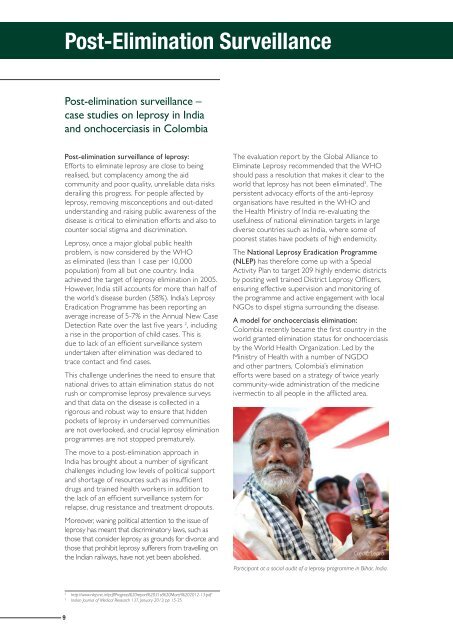1jeGTyf
1jeGTyf
1jeGTyf
You also want an ePaper? Increase the reach of your titles
YUMPU automatically turns print PDFs into web optimized ePapers that Google loves.
Post-Elimination Surveillance<br />
Post-elimination surveillance –<br />
case studies on leprosy in India<br />
and onchocerciasis in Colombia<br />
Post-elimination surveillance of leprosy:<br />
Efforts to eliminate leprosy are close to being<br />
realised, but complacency among the aid<br />
community and poor quality, unreliable data risks<br />
derailing this progress. For people affected by<br />
leprosy, removing misconceptions and out-dated<br />
understanding and raising public awareness of the<br />
disease is critical to elimination efforts and also to<br />
counter social stigma and discrimination.<br />
Leprosy, once a major global public health<br />
problem, is now considered by the WHO<br />
as eliminated (less than 1 case per 10,000<br />
population) from all but one country. India<br />
achieved the target of leprosy elimination in 2005.<br />
However, India still accounts for more than half of<br />
the world’s disease burden (58%). India’s Leprosy<br />
Eradication Programme has been reporting an<br />
average increase of 5-7% in the Annual New Case<br />
Detection Rate over the last five years 2 , including<br />
a rise in the proportion of child cases. This is<br />
due to lack of an efficient surveillance system<br />
undertaken after elimination was declared to<br />
trace contact and find cases.<br />
This challenge underlines the need to ensure that<br />
national drives to attain elimination status do not<br />
rush or compromise leprosy prevalence surveys<br />
and that data on the disease is collected in a<br />
rigorous and robust way to ensure that hidden<br />
pockets of leprosy in underserved communities<br />
are not overlooked, and crucial leprosy elimination<br />
programmes are not stopped prematurely.<br />
The move to a post-elimination approach in<br />
India has brought about a number of significant<br />
challenges including low levels of political support<br />
and shortage of resources such as insufficient<br />
drugs and trained health workers in addition to<br />
the lack of an efficient surveillance system for<br />
relapse, drug resistance and treatment dropouts.<br />
Moreover, waning political attention to the issue of<br />
leprosy has meant that discriminatory laws, such as<br />
those that consider leprosy as grounds for divorce and<br />
those that prohibit leprosy sufferers from travelling on<br />
the Indian railways, have not yet been abolished.<br />
The evaluation report by the Global Alliance to<br />
Eliminate Leprosy recommended that the WHO<br />
should pass a resolution that makes it clear to the<br />
world that leprosy has not been eliminated 3 . The<br />
persistent advocacy efforts of the anti-leprosy<br />
organisations have resulted in the WHO and<br />
the Health Ministry of India re-evaluating the<br />
usefulness of national elimination targets in large<br />
diverse countries such as India, where some of<br />
poorest states have pockets of high endemicity.<br />
The National Leprosy Eradication Programme<br />
(NLEP) has therefore come up with a Special<br />
Activity Plan to target 209 highly endemic districts<br />
by posting well trained District Leprosy Officers,<br />
ensuring effective supervision and monitoring of<br />
the programme and active engagement with local<br />
NGOs to dispel stigma surrounding the disease.<br />
A model for onchocerciasis elimination:<br />
Colombia recently became the first country in the<br />
world granted elimination status for onchocerciasis<br />
by the World Health Organization. Led by the<br />
Ministry of Health with a number of NGDO<br />
and other partners, Colombia’s elimination<br />
efforts were based on a strategy of twice yearly<br />
community-wide administration of the medicine<br />
ivermectin to all people in the afflicted area.<br />
Credit: Lepra<br />
Participant at a social audit of a leprosy programme in Bihar, India.<br />
2<br />
http://www.nlep.nic.in/pdf/Progress%20report%2031st%20March%202012-13.pdf<br />
3<br />
Indian Journal of Medical Research 137, January 2013, pp 15-35<br />
9


